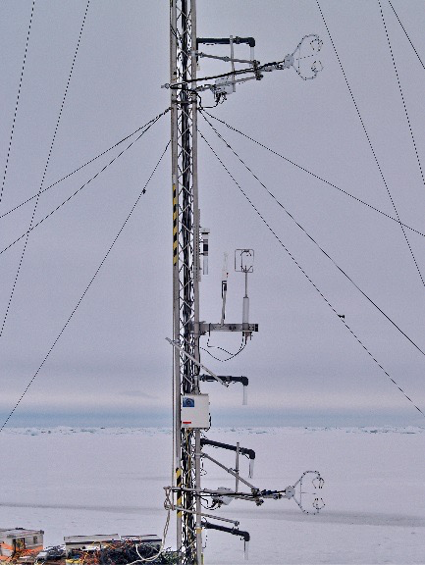Arctic Summer Cloud-Ocean Study
Micrometeorological data
Measurements of subtle meteorological variables, such as gradients of wind and temperature near the surface, turbulence and the corresponding turbulent fluxes of momentum and of sensible and latent heat requires a reasonably homogeneous fetch and are very complicated to perform on a ship due to the flow distortion. Hence a micrometeorological observatory was deployed on the during the ice drift ice, some distance away from the ship. This site was labeled “Met Alley”, since the deployment was along an “alley” approximately away from Oden, to minimize the ship’s blocking sector; the site was manned 24/7. The site consisted of two masts; one 15-m mast with instruments at five levels and one single level 30-m mast. The main instrumentation in the masts consisted of sonic anemometers and two Licor open path gas analyzers. Additional observations include aspirated and radiation-shielded mean temperature and relative humidity at two levels, up- and downward long- and shortwave radiation at an undisturbed location some distance away, surface temperature observations at the surface and a few levels into the snow and ice, and so-called surface heat-flux plates and a few levels from the surface and into the snow; the lowest of these at the interface between snow and ice. Primary problems with the mast observations were icing of the sensors; the lowest instruments in the 15-m mast, within reach from the surface were more easily maintained while the uppermost instrument in the 30-m mast was heated and has an almost unbroken record. Problems with the surface temperature observations is potential solar heating of uppermost levels, and melting and accumulation of new snow, making the exact positioning of the sensors uncertain; they were repeatedly repositioned. Also for radiation, the primary problem was icing on the upward-facing domes, that had to be cleaned manually. All the data is contained in one single file.
Download
 Close-up photo of the 15-m mast, showing three sonic anemometers; two CSAT (top and bottom) and one Gill (middle) and three levels of the aspirated temperature profile, along with one mean TRH (close to the mast) and one Licor open-path gas analyzer (w/ the Gill).
Close-up photo of the 15-m mast, showing three sonic anemometers; two CSAT (top and bottom) and one Gill (middle) and three levels of the aspirated temperature profile, along with one mean TRH (close to the mast) and one Licor open-path gas analyzer (w/ the Gill).